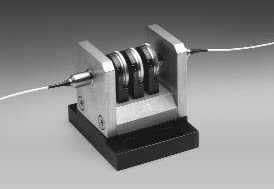
Control of polarization is achieved through the use of 1/4-Wave and 1/2-Wave Retarders whose parameters are not affected by environmental changes on the fiber. This accounts for the stability of the OFR Polarization Controller. A Linear Polarizer is the third Module in the PC-FFB. It precedes or follows the 1/4-Wave and 1/2-Wave Retarders (in that order) according to the application. See www.ofr.com/fiberbenches/ polarizationcontroller. In contrast, looped fiber controllers are sensitive to environmental changes, and therefore must be frequently adjusted. In all FiberBench Coupling Systems using OFR PM FiberCables, both the fast axis and the FC receptacle keyway are vertical. Both the plane of polarization and the fiber stress rods are horizontal. A major feature of OFR FiberBench Coupling Systems is stability. Transmittance remains constant after temperature change, shock and vibration far greater than experienced in typical laboratory use.
|
|||||||||||||||||||||||||||||||||||||||||
Optics
for Research ·
Ph 973-579-7227 · Fax 973-300-3600 · Email: info@ofr.com
![]()

